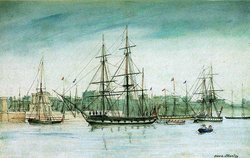|

Darwin in the very beginning got seasick and regretted for a time that he came. The voyage
was delayed because of a break out of cholera in Santa
Cruz at Tenerife
Island. They had to wait for 12 days to get on land. The captain Robert FitzRoy wanted to go ahead
and go to the Cape Verde Islands so they wouldn't lose anytime. Darwin first made
his observations at Santiago. Where he found a cuttle-fish that amazed him when it changed colors. They stopped
quickly at Fernando de Noronha it was a very volcanic region. They then sailed forth to Salvador then Bahia, Brazil. At Salvador Darwin loved its beautiful landscapes but later got in fight with
FitzRoy about slavery. Then in All Saints Bay he observed a small tube-like animal that made the ocean look brown. In Rio de Janeiro he stayed there while the ship made other stops. He explored a tropical rainforest while there. He
then collected many specimens. His collection consisted of many insects and plants. They then headed to Buenos Aires after again he boarded the ship but again soon fell sick. In Fort Argentina they were suspected to be spies because of Darwin's weird looking instruments. Darwin later got off the
H.M.S. again to collect and found some fossils. It was very exciting to him because many of the animals he saw were not known
to the science community at that time. In Montevideo he kind of had a time to relax he received mail from family and sent specimens
to his mentor Rev. Henslow. It included part of a skull of the Cavia, several marine shells, an odd looking bird, some
snakes and lizards, a toad, many crabs, dried plants, fish, some seeds, and a lot of beetles. In Tierra del Fuego they were
stunned by the natives’ behavior and how they mocked them. Darwin tried to climb Banks
Hill but it had too much vegetation and he gave up. Much later they arrived in the Falkland Islands. Darwin
was surprised on how different the fossils were here than on the coast of South America. Later in the journey they went to
Maldonado at first he was highly disappointed because he found the scenery depressing later he hired a crew to go further
inland. He was then happily surprised when he found and saw many exotic animals and saw many ostriches. During his stay he
had another culture shock and liked the people here. Later they returned back to Montevideo and
he collected even more specimens and considered himself very lucky for it. Much later they went to Rio Santa Cruz and made
a theory that the Andes Mountains slowly changed over time and rose above sea level. Then they went around the South
American Cape and started into the Pacific Ocean. Darwin then went to the Galapagos
Islands. This was his most famous place that he visited
on H.M.S. Beagle. The crew and Captain went there like most ships did to collect tortoise meat for the way home. Darwin
got off and was very amazed at all the animals he found there. There he noticed like others how different the animals were
here. Also that animals from one area to another varied like finches or turtles. They all seemed exactly right for the habitat
they lived in. Darwin later used all of his information and fossils from the H.M.S. Beagle to draw his
conclusion to evolution.
|




